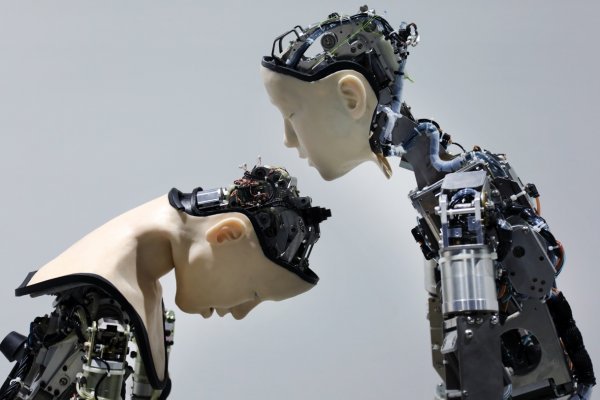Inspired by Shintoism, Justine Emard has been collaborating with Japanese scientists since 2016. The resulting video works Co(AI)xistence (2017), Soul Shift (2018), and Symbiotic Rituals (2019) signify a body of work that is at once technological, poetic, and visual. Alter, an android robot developed by Ishiguro Lab (Osaka University) and Ikegami Lab (Tokyo University), is controlled by an Artificial Intelligence and brought to life through communication. Equipped with different intelligences, humans and robots interact through signs and signals of their respective expressions, both physical and verbal. Through their shared experience, they seek to define new perspectives of living together in the world.
Co(AI)xistence
2017, Video installation, 12’
(with Mirai Moriyama and Alter, programmed by Ishiguro’s Lab, Osaka University and Takashi Ikegami, Tokyo University)
Co(AI)xistence creates an artistic interface between digital data and human movement. Justine Emard staged an interaction between the actor and dancer Mirai Moriyama and the robot Alter, animated by an AI based on a neural system programmed by the laboratory of Takashi Ikegami (University of Tokyo) and whose humanoid incarnation was created by the laboratory of Hiroshi Ishiguro (Osaka University).
Equipped with different intelligences, the human and the robot engage in a dialogue through the signals of their respective expressions, both physical and verbal. Using a deep-learning system, the robot can learn from its encounter with the dancer, a process that is not anthropomorphic but is essentially computational.
Through their shared experiences, the human and the humanoid Alter seek to define new perspectives of living together in the world.
Soul Shift
2018, Video, 6’
(with Alter and Alter 2, programmed by Ishiguro’s Lab, Osaka University and Takashi Ikegami, Tokyo University)
Alter is a humanoid robot that seems to wake up while communicating with him when he is activated. Equipped with sensors that inform his neural network about his environment, he is completely autonomous. He invents his gestures, conditioned by the capabilities of his limbs, which are similar to our movements but not human, as they are generated with extreme precision by an AI.
He - or possibly she, since the machine is genderless - seems to discover the inactive robot of which he is the real double or second version.
The experience or "spirit" of Alter 1 is transferred to Alter 2, reminiscent of a form of reincarnation.
Face to face, the active Alter 2 seems to be affected by the sight of Alter 1 -
by the possible encounter with an earlier version of himself: he approaches the other in recognition and affection.
Symbiotic Rituals
2019, Video, 3’40
(with Alter 2 and Alter 3 co-developed by Ikegami Lab, Tokyo University (Ikegami Takashi, Maruyama Norihiro, Masumori Atsushi, Doi Itsuki) and Ishiguro Lab, Osaka University (Ishiguro Hiroshi, Ogawa Kohei) Music: Keiichiro Shibuya, Co-production: mixi, inc. / Production Support: Miraikan – National Museum of Emerging Science and Innovation, ATAK, johnsmith, Hori Hikaru)
In Symbiotic Rituals, Justine Emard introduces the idea of collective intelligence into her work. Between reality and unreality, the laboratory becomes a stage for the emergence of life.
The next stage of intercommunication is formed by the encounter of the next (the third) generation of the robot Alter with its predecessor Alter 2.
This unpredictable moment of interaction, embedded in Keiichiro Shibuya's music that fuses sounds and voices, happens in the dark, with only dim LED lights creating shadows on the walls.
The staging reminds us of the Platonic Allegory of the Cave and raises the question of whether we see images, machines or beings?









